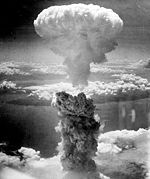- Metallurgical Laboratory
-

The Metallurgical Laboratory or "Met Lab" at the University of Chicago was part of the World War II–era Manhattan Project, created by the United States to develop an atomic bomb. It was where Enrico Fermi created the first self-sustaining nuclear chain reaction under the university's football stadium.
Contents
History
In July 1939, at the urging of physicists Eugene Wigner and Leó Szilárd, Albert Einstein sent a letter to President Franklin D. Roosevelt explaining the military potential of nuclear fission and calling for the United States to develop atomic weapons before Nazi Germany did.
In response, Roosevelt appointed a committee to direct the research. Early funding was meager, but in 1940, scientists at Columbia University and the University of California were able to demonstrate the weapons potential of the isotope uranium-235 and the newly-discovered element plutonium.
Immediately after the Japanese attack on Pearl Harbor on December 7, 1941, Nobel Prize laureate Arthur H. Compton quickly gained support for consolidating plutonium research at Chicago and for an ambitious schedule that called for producing the first atomic bomb in January 1945, a goal that was missed by only six months.
"Metallurgical Laboratory" was the "cover" name given to Compton's facility. Its objectives were to produce chain-reacting "piles" of uranium to convert to plutonium, find ways to separate the plutonium from the uranium and to design a bomb. Most of the offices were in the university's Eckhart Hall; Szilard later wrote that "the morale of the scientists could almost be plotted in a graph by counting the number of lights burning after dinner in the offices at Eckhart Hall."[1]
In August 1942, a team of scientists under Glenn T. Seaborg isolated the first weighable amount of plutonium from uranium irradiated in cyclotrons. Meanwhile, work continued under the renowned Italian physicist Enrico Fermi to build uranium and graphite piles that could be brought to critical mass in a controlled, self-sustaining nuclear reaction.
A labor strike prevented the construction of the piles at a laboratory in the Argonne forest preserve, so Fermi and his associates Martin Whittaker and Walter Zinn set about building the piles (really the world's first "nuclear reactor," although that term was not used until 1952) in a racquets court under the abandoned west stands of the university's Alonzo Stagg Field.[2] The piles consisted of uranium pellets as a neutron–producing "core" separated from one another by graphite blocks to slow the neutrons. Fermi himself described the apparatus as "a crude pile of black bricks and wooden timbers." The controls consisted of cadmium-coated rods that absorbed neutrons. Withdrawing the rods would increase neutron activity in the pile to lead to a self-sustaining chain reaction. Re-inserting the rods would dampen the reaction.
On December 2, 1942, Chicago Pile 1 (CP-1) was ready for a demonstration. Before a group of dignitaries, a young scientist named George Weil worked the final control rod while Fermi carefully monitored the neutron activity. The pile went critical at 3:20 p.m. Fermi shut it down 33 minutes later. In 1943, he rebuilt the pile as CP-2 at the Argonne National Laboratory, in Red Gate Woods.
The stadium was demolished in 1957. The location is commemorated as the Site of the First Self-Sustaining Nuclear Reaction, a National Historic Landmark, featuring a sculpture by Henry Moore.
See also
George Herbert Jones Laboratory
Notes
- ^ Richard Melzer (1999). Breakdown: How the Secret of the Atomic Bomb was Stolen During World War II. Sunstone Press. ISBN 9780865343047. http://books.google.com/books?id=saYDEcj0hI0C&pg=PA105&dq=chicago+met.lab+offices&sig=rJ3VDugfZVtO-u17GQbrlouKeDY.
- ^ Zug, James (2003). Squash, A History of the Game. Scribner. pp. 135–136. ISBN 978-0743229906. The space is commonly misidentified as having been a squash court.
External links
- The First Pile by Corbin Allardice and Edward R. Trapnell
- Manhattan Project Signature Facilities
- Oak Ridge National Laboratory Review
- Chicago Pile 1 Pioneers
- The First Pile
- The Manhattan Project: Making the Atomic Bomb
University of Chicago Academics Schools
Other
The College · Divinity School · Booth School of Business · Harris School of Public Policy Studies · Law School · Pritzker School of Medicine · School of Social Service Administration · Graham School of Continuing Liberal and Professional Studies
Argonne National Laboratory · Chicago school of economics · Committee on Social Thought · Fermilab · Oriental Institute · Laboratory Schools · Sonia Shankman Orthogenic School · Milton Friedman Institute · Medical Center · Yerkes ObservatoryResidence halls Campus Chicago Theological Seminary · George Herbert Jones Laboratory · Gerald Ratner Athletics Center · Hutchinson Hall · John Crerar Library · Lorado Taft Midway Studios · Midway Plaisance · Oriental Institute · Quadrangle Club · Regenstein Library · Renaissance Society · Robie House · Rockefeller Chapel · Seminary Co-op · Smart Museum of Art · Stagg FieldHistory Chicago Pile-1 (Nuclear Energy) · Alumni · Faculty · Metallurgical Laboratory · Nobel Laureates · Old University of ChicagoSports and traditions Student organizations The Chicago Maroon · Chicago Weekly · Counterpoint · Off-Off Campus · The Chicago Review · The Midway Review · Doc Films · University of Chicago Band · WHPK-FM · Voices in Your Head
Wikimedia Foundation. 2010.

